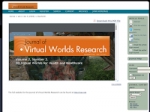
Chatbot listing, virtual agents, virtual assistants, chat bot directory, conversational agents, virtual human news, chatterbot list
NEWS: Chatbots.org survey on 3000 US and UK consumers shows it is time for chatbot integration in customer service!read more..
Chatbots as Virtual Patients
 Virtual Worlds such as Second Life provide unique opportunities to simulate real life scenarios and immerse the user in an environment that can be tailored to meet specific educational requirements. In these Immersive Learning Environments, students and faculty can interact from anywhere in the real world. From a general education perspective, they allow for virtual classrooms, virtual libraries, interactive role-playing, remote seminars, etc. From a medical education and science perspective, Immersive Learning Environments such as Second Life can be used to model doctor-patient interaction, clinical diagnosis skills, and three dimensional objects ranging from individual molecules and cells to whole organ systems, both healthy and diseased.
Virtual Worlds such as Second Life provide unique opportunities to simulate real life scenarios and immerse the user in an environment that can be tailored to meet specific educational requirements. In these Immersive Learning Environments, students and faculty can interact from anywhere in the real world. From a general education perspective, they allow for virtual classrooms, virtual libraries, interactive role-playing, remote seminars, etc. From a medical education and science perspective, Immersive Learning Environments such as Second Life can be used to model doctor-patient interaction, clinical diagnosis skills, and three dimensional objects ranging from individual molecules and cells to whole organ systems, both healthy and diseased.The principal goal of our project is the development of virtual patient simulations for medical education. In order to simulate real patients with greatest fidelity, the virtual patients are controlled by artificial intelligence. This allows students to engage in a natural language conversation with the patient to obtain relevant patient history, symptoms, etc, and then to develop relevant differential diagnoses and treatments appropriate for the simulated condition of the patients. Virtual world medical simulations enable students to rehearse professional behaviors in a risk-free environment, providing opportunities for skills practice prior to real-world patient encounters.
New Comment
Only registered members are allowed to comment. or login
or login
